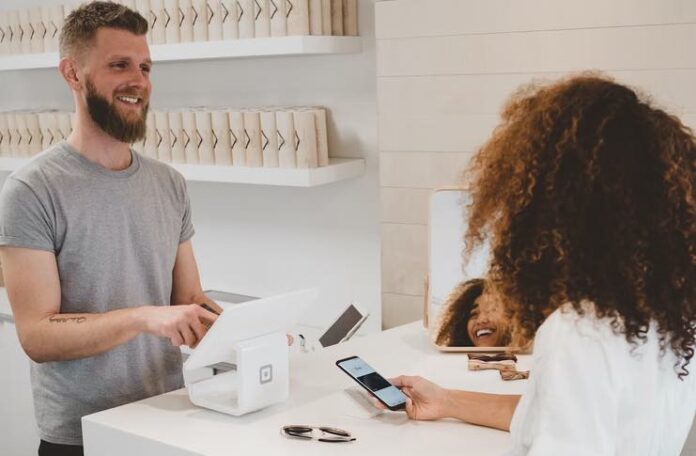
The retail industry thrives on strategies that are designed to maximize customer interaction. Among these, upselling and cross-selling are two particularly popular methods that savvy retailers employ to increase their average transaction value. Cross-selling involves recommending different products or services to the same customer during a sale, while upselling pertains to recommending a product or service that’s higher in value due to its quality or usefulness to the customer.
When done correctly, these techniques can boost a retailer’s revenue, enhance their customer satisfaction, and foster brand loyalty—all of which matter in an increasingly competitive retail landscape. The POS point of sale area plays a vital role in these processes because it serves as the last touchpoint to engage customers before they conclude their purchase.
If you run a retail business from a brick-and-mortar store, or if your online business has a physical counterpart from which you enact sales, here are ten helpful strategies to master upselling and cross-selling at your store’s POS area.
1) Leveraging the Power of the POS
The POS area is more than just a place to complete transactions. Business owners that run brick-and-mortar establishments or that do sales from physical venues like bazaars should recognize it as a stage for showcasing products, engaging customers, and providing opportunities for incremental sales.
Recognizing your POS system as a strategic component in your sales process is the first step in unlocking its potential. Indeed, high footfall and customer interaction make the POS the ideal hotspot for both upselling and cross-selling. A wise retailer will design their POS area to encourage customers to make additional purchases or opt for higher-value products. Take the cue from the best in the industry and prepare your POS area for increased upselling and cross-selling activity.
2) Utilizing Strategic Product Placement
The science of product placement at the POS area is also key when it comes to influencing customer purchase behavior. Positioning higher-value products or items with the highest profit margins at eye level can naturally draw your customers’ attention and encourage upselling.
In the same vein, placing related items next to each other can prompt customers to buy additional products that complement their main purchase. Considerations like flow, spacing, and visibility at the POS area and the zones linking to it can greatly affect a customer’s perception and make them inclined towards buying more.
3) Capitalizing on Technology
POS systems have evolved beyond simple cash registers. Today, a digital POS system like Maya Business’s Maya Terminal can display product comparisons, suggest add-ons based on previous purchases, or offer personalized recommendations based on a customer’s buying history.
Integrating such technology into your store’s overall POS system can help you roll out a more interactive shopping experience and nudge customers towards making additional purchases or selecting more expensive options. You can also add digital signage and displays to attract attention and make the POS area more engaging.
4) Mastering the Art of Empathetic Upselling
Successful upselling requires you to understand your customer’s needs and provide appropriate solutions. By empathetically engaging customers and showcasing how a higher-value product fulfills their requirements better, you can persuade them to upgrade their purchase.
Remember that this strategy is not about pushing expensive items just for the sake of it, but demonstrating value in a manner that resonates with the customer. Training your sales staff to approach upselling in an empathetic manner can lead to both better customer relationships and increased sales.

5) Implementing Effective Upselling Techniques
Upselling techniques can vary across different retail sectors, but the basic principles remain the same: understanding a customer’s needs, presenting a better product, and demonstrating that product’s value.
Knowing that, upselling is a skill that requires training and practice. Your sales staff should have deep knowledge about your products, their features, and their benefits for the former to be able to compare them effectively.
On top of training your staff in effective upselling techniques, you can also use visual tools around your POS area to bolster your staff’s efforts. Comparison charts, for example, can help customers visualize the added value of a more expensive product and justify their increased spending.
6) Nurturing Product Knowledge for Cross-Selling
Cross-selling hinges on your ability to naturally introduce additional and similarly relevant items to your customers. You’ll want your staff to build a comprehensive knowledge of your products so that they can establish connections between primary purchases and related add-ons.
Encourage your team to explore various product combinations that can enhance the customer’s usage experience, for example, related cooking tools that will allow them to prepare their favorite meals in the kitchen. The more adept your staff are at finding relevant connections, the more effectively they can cross-sell.
7) Displaying Cross-Sell Items Effectively
The visual appeal of a whole family of products on display can significantly influence a customer’s decision to buy more than one product in the set. To that end, it’s a good idea to strategically arrange several products at your POS area to draw attention and stimulate interest.
Display cross-sell items in an organized and visually appealing manner to attract customers. Experiment with innovative display methods, like themed setups or pairing complementary products with each other, to make the items more enticing. Again, the goal is to add value to the customer’s purchase, so make sure the items being cross-sold are actually relevant and beneficial to the customer.
8) Learning from Success
Giants in the global retail industry have attained their status due to their masterful use of upselling and cross-selling strategies. Consider the case of retail stores in the Philippines, where these techniques have been employed rather effectively to increase sales.
Find success stories that you can glean insights from and adapt the practices you’ve learned from retail giants in your own store. Draw inspiration, for example, from the local retail sector’s emphasis on its personalized customer service and strategic use of POS Philippines systems, as these can be replicated and customized according to your store’s context.
9) Staying Ahead with Future Trends
Given how rapidly the retail landscape is evolving, you’ll definitely want to keep up with emerging trends and practices in both upselling and cross-selling. Factors that will shape the future of these sales techniques include advancements in technology, shifts in consumer behavior, and the increasing role of data analytics in retail operations.
Make sure to regularly research industry trends, participate in retail seminars and workshops, and monitor your competition to stay ahead of the curve. An adaptable retailer is a successful retailer, and this very much applies in the practices of cross-selling and upselling.
10) Evolve and Refine Your Strategies Continuously
No cross-selling or upselling strategy is static or foolproof. It’s also important for you to regularly review the effectiveness of your upselling and cross-selling techniques at the POS area. Gather customer feedback, monitor your sales data, and conduct staff reviews to understand what’s working and what’s not. Based on these insights, make it a point to refine and evolve your strategies to ensure they remain effective and responsive to your customer’s preferences.
Conclusion
Upselling and cross-selling are more than just sales techniques; they are opportunities to provide customers with added value and enhance their shopping experience. The POS area, being a critical customer touchpoint, offers a unique stage to implement these strategies effectively.
Leverage the power of your POS, invest in new technologies that could improve your store operations, nurture your knowledge of your products, and continually refine your usage of cross-selling and upselling strategies. This way, you can unlock your retail store’s full potential and leave your customers happy about the time and money they spend in your establishment.
Arun is an avid blogger and business expert. He’s been in business from the moment he finished school and hasn’t stopped growing ever since.




